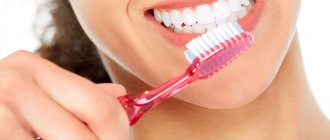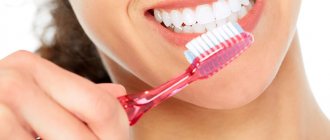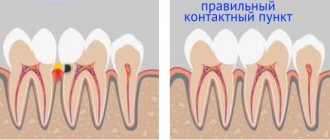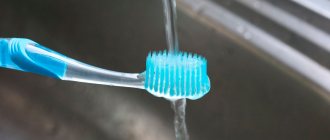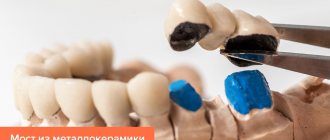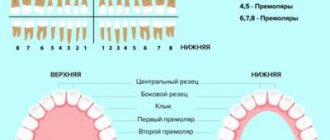Any toothbrush has a limited lifespan. Over time, the bristles wear out and fall out, microbes accumulate on them, and it becomes useless and even dangerous for the teeth. There is a risk of developing caries, periodontal disease and other diseases. To prevent this from happening, you need to periodically change the brush. Let's find out how often to do this and why.
In this article
- Why you need to change your toothbrush
- How often should you change your brush?
- How often should you change your electric toothbrush?
- How to determine that your toothbrush needs to be changed
- What happens if you don't change the brush?
Complete oral hygiene includes not only the daily use of brushes, pastes, rinses and balms, but also regular replacement of hygiene products. Otherwise, they can turn into a risk factor and lead to the development of dental diseases. We'll tell you why you need to change your brush regularly and when to do it.
Why you need to change your toothbrush
A brush used regularly, over time, not only loses its appearance and the original elasticity of the bristles, but also becomes an accumulator of a large number of harmful bacteria transferred from the surface of the teeth and gums. With short-term use, the density of bacterial accumulation is not too high and cannot cause harm. After some time, bacteria accumulate and can “relocate” back to the surface being cleaned, creating the risk of developing many negative consequences. Bristles that have lost their elasticity not only contribute to this transfer, but can also become a traumatic factor for the gums, further aggravating the current situation.
the most acceptable period for changing a toothbrush to be 3 months. If necessary, a replacement can be made earlier than the specified time, but it is highly undesirable to postpone the purchase of hygiene products for a longer period.
Brushes with indicators
Most modern toothbrushes from well-known manufacturers have an indicator in the form of a colored stripe applied to the bristles. As the product is used, the indicator fades and changes color (or disappears completely). As soon as this happens, the product should be replaced, as it becomes unsuitable for further use.
How often should adults and children change their toothbrush?
For proper cleaning, many dentists recommend changing your toothbrush every 1-3 months. Natural bristles are the least resistant to wear and tear. Elastic fibers quickly break off and become frayed, becoming unsuitable for proper cleaning.
How often should an adult change their toothbrush?
In connection with the above information, adults need to change toothbrushes once every 1-2 months.
Thus, answering the question: how many times should you change your toothbrush , you can answer: 4-6 times a year. It is worth considering that the indicated amount may vary depending on the factors listed above.
How often should children change their toothbrush?
A child's first toothbrush is a silicone massager that fits on the finger. The use of this device is advisable during the period of eruption of the first teeth and provides not only their cleaning, but also massage of the gingival surface. After each use, the massager must be disinfected in a special solution, or by boiling. In this regard, we are not talking about the accumulation of pathogenic bacteria in this case. However, gum massagers need to be replaced every 3-4 months.
When a child reaches the age of 1 year, it becomes necessary to use a full-fledged toothbrush. The choice most often leans towards bristles made from synthetic materials, which are least susceptible to contamination by microorganisms, have high elasticity and are easier to process. Starting from the age of 2, brushing teeth with brushes that have both synthetic and natural bristles is acceptable. A child's toothbrush is replaced at the same frequency as for adult family members; therefore, children of this age should change their toothbrush once every 2-3 months.
Is it possible to boil a brush?
A few decades ago, people used a rather dubious method of keeping toothbrushes clean - boiling. The part of the product on which the bristles are located was placed in a shallow container, after which the pan or enamel ladle was placed on the stove over low heat. The boiling procedure took from 5 to 7 minutes.
This method is not safe and can only worsen the properties of the brush. Modern products are made of synthetic pile, which quickly loses its shape and cleaning properties when exposed to high temperatures. Boiling at +100°C, of course, allows you to destroy almost all viruses and bacteria located on the surface of the bristles, but you cannot use such a brush to clean your teeth - it will injure the enamel and gums, which will increase the risk of inflammatory processes and pathogenic microorganisms entering damaged areas.
Fact! Boiling brushes was common in the 19th century, when most products were made from natural materials - horse, pig or badger hair. Such bristles were quite resistant to heat and made it possible to extend the service life of the product to 6-8 months.
How often should you change your electric toothbrush?
The electric toothbrush itself is designed for a long service life, estimated at several years and depending primarily on the performance of the motor performing the work. Cleaning attachments must be replaced regularly. It is recommended to change them in the same way as a regular brush, i.e. every 2-3 months, unless circumstances arise that require a reduction in the specified period (damage to the bristles, previous diseases, mold damage, etc.). This is due to the fact that the bristles for the attachments are made from the same materials as regular toothbrushes. Read more about the benefits and harms of electric toothbrushes here.
Is it possible to brush your teeth longer than the allotted time?
Brushing your teeth with a brush that has served its purpose is dangerous for the condition of your gums and teeth. Minimal harm from use is poor cleaning. Plaque and bacteria that accumulate daily can cause major problems, such as the formation of tartar and caries.
If bacteria get into the micro-wounds on the gums, the inflammatory process will not take long to occur. If left untreated, gingivitis can lead to periodontitis and subsequent tooth loss. Therefore, you should not neglect the established sanitary and hygienic rules. Knowing how often you need to change your regular or electric toothbrush will protect you from possible opportunistic infections and maintain your oral health.
How to tell when your toothbrush needs to be replaced
The maximum period of use of even the best brush is 3-4 months. Even if it seems cleanable and looks good, it is still worth replacing. The main reasons for replacing your toothbrush are listed below:
- The service life of the brush exceeded 3 months;
- After suffering infectious diseases, to avoid re-infection;
- Wear of the bristles, their fraying, change in original color;
- Accumulation of plaque, visually noticeable on the surface;
- Use of a brush by another person;
- The appearance of signs of black mold infestation;
How to restore stubble?
The procedure for restoring bristles is carried out at home.
Sometimes the service life of the bristles ends a few days after purchasing the device. How to restore a toothbrush?
The instructions look like this:
- Boil water in a kettle.
- Pour it into a deep container.
- Dip the bristles into water and perform several rotational movements.
The duration of this procedure is 60-120 seconds. The condition of the bristles should be checked periodically. If you carry out this procedure from time to time, the shelf life of your toothbrush can be slightly extended.
What happens if you don't replace your toothbrush on time?
A toothbrush used for more than several months, after a certain time, not only loses its aesthetic appeal, but can also become an object that can cause at least discomfort during use. In the worst case scenario, a toothbrush not replaced in a timely manner can cause many problems, such as:
- Injury to the gums and bleeding;
- Infection of soft tissues of the oral cavity;
- Development of gingivitis, periodontal disease and caries;
- Increased level of plaque accumulation;
- Unpleasant odor;
- Possibility of re-infection after illness;
- The risk of contracting a number of diseases if another person used the toothbrush.
In order for the toothbrush to fully and safely perform its functions during the permissible period of use, it is necessary to adhere to the rules of care and storage.
What are the consequences of untimely replacement?
Although it's tempting to extend the life of your toothbrush, you shouldn't do it. Using it too long will lead to serious problems:
- discomfort/pain during cleaning;
- microtraumas of the oral cavity;
- bleeding gums;
- infection of soft tissues;
- inflammation of gum tissue;
- development of gingivitis, caries, periodontal disease and other diseases;
- development of systemic infections;
- formation of dental plaque, stone;
- the appearance of bad breath.
If your teeth are not properly cleaned, you will have to visit the dentist more often, and this is a much greater inconvenience than replacing your brush every quarter.
If it is difficult for you to keep track of the timing, it makes sense to purchase a brush with an indicator - at the end of its service life, the bristles will change color and indicate that it is time to replace it. And even if you conscientiously change hygiene products strictly at the allotted time, you should not forget about caring for them, this is the only way to protect yourself from dental diseases and enjoy life without pain.
Rules for the care and storage of a toothbrush
- After each use, the toothbrush is thoroughly rinsed under running water. For better processing, you can rinse the brush in boiling water. However, prolonged contact with high temperatures can cause damage to the bristles;
- At least once a week, the brush must be treated with a disinfectant solution. An affordable and high-quality disinfectant is ordinary hydrogen peroxide;
- The toothbrush is stored in a container that has holes to drain any remaining water on the bristles. Otherwise, black mold, which is extremely dangerous to health, may form, both on the glass and on the toothbrush itself. The ideal option would be to dry the bristles and use special cases that have the ability to emit ultraviolet light;
- It is recommended to store the toothbrush covered in a special cap that protects the bristles from external influences.
Separately, you should pay attention to the hygiene products that were used during the trip or hospital stay. Such toothbrushes must be replaced with new ones immediately after returning home. This is due to the fact that under these conditions, the risk of bristle infection by various pathogens increases significantly.
In addition to proper storage of the brush, accuracy in its choice plays a big role.
How to properly care?
The main maintenance requirement is regular washing with antibacterial or laundry soap.
The instructions look like this:
- After each use, rinse the brush thoroughly. To do this, you should use baby soap. Rinsing is carried out with warm water.
- Place a protective case on top.
- Wash the product regularly with an antibacterial solution. This needs to be done 1 time/7 days.
- Before placing the brush in the case, the bristles must be thoroughly dried. In a humid environment, microbes develop very quickly.
- Wash and thoroughly dry the storage cup once a week. This way you can prevent the product from becoming damaged by mold.
Note! Children's and adult equipment should not be stored in the same cup. It is not advisable to keep a razor next to a hygiene product.
How to choose the right toothbrush
Bristle hardness
Manufacturers offer bristles of 3 types of hardness:
- Soft. Suitable for children and people suffering from gum disease that causes bleeding and pain;
- Medium hardness. It is a classic option, most popular among consumers. This is explained by the optimal balance between a delicate attitude during processing and good cleaning quality. Such bristles are suitable for both natural teeth and most types of dentures;
- Tough. High-stiffness bristles should only be used on the recommendation of a doctor. As a rule, an indication for the use of such brushes may be excessively increased formation of dental plaque.
Location and shape of bristles
Angled, beveled bristles remove plaque more effectively and allow you to thoroughly clean your molars. Multi-level trimming of the bristles allows you to clean the side surfaces of the teeth and penetrate even into narrow spaces. The presence of oblique beams increases the coverage area and extends, including to the area of the tooth neck.
Should I use an irrigator?
The irrigator thoroughly cleans the interdental spaces
Is a waterpik a substitute for a toothbrush? The principle of its operation is that under the influence of a certain pressure, food debris is washed out from the interdental spaces and hard-to-reach places.
The main advantages of the irrigator include:
- washing of periodontal pockets;
- delicate and thorough gum massage;
- reducing the risk of developing an inflammatory process.
Note! The irrigator does not replace a toothbrush. It cannot cope with old plaque and is used only as an additional hygiene product.
Main types
Dentists distinguish 2 types of irrigators: portable and stationary. The first has an impressive water tank. It is also called family friendly because all family members can use it. This device operates from the electrical network.
The portable irrigator is battery powered. It has a small liquid reservoir. The power of water pressure can be easily adjusted.
Attachments for the device
The plate lists the main types of irrigator attachments.
Table 3. Basic attachments for the device.
| Type of nozzle | Description |
| Intended for the treatment of periodontal pockets. To avoid discomfort, the power should be adjusted. |
| Located closer to the root. It is advisable to start cleaning with minimal power. |
| Intended for treating areas in the area of implants. |
Useful tips
There are recommendations that allow you to brush your teeth efficiently:
- You should not start cleaning earlier than 15 minutes after eating. This increases the effectiveness of the paste. After eating some food, for example, spicy or sour, the procedure should be performed no earlier than half an hour later.
- It is advisable to brush your teeth after breakfast and before going to bed at night. Dentists consider this time to be the most suitable for these procedures. Brushing before bed prevents the growth of harmful microorganisms in the mouth, since the salivary glands function weakly at night.
- Cleaning should be done for at least 3 minutes, but do not overdo it. Cleaning for too long (more than 10 minutes) can lead to problems with the enamel, especially when using a paste with a high fluoride content.
- During the day, you need to use toothpicks to remove food particles in the interdental space. The procedure must be performed carefully to prevent injury to the gums and infection in the wound.
- You should independently identify problem areas and give them due attention. For effective care, it is advisable to consult a dentist.
- You should pay attention to the gums, since often beneficial effects for the teeth lead to damage to other areas of the cavity. Bleeding gums can be a symptom of gingivitis.
- Using mouthwashes is not necessary, but it provides a comprehensive approach to prevention.
Siwak tree sticks
This is another answer to the question of how to brush your teeth if you don’t have a toothbrush. Siwak tree sticks are sold online in vacuum packaging, which includes several pieces. In ancient times they were used for cleaning. One stick can be used for a month.
You just need to follow the general storage rules: keep the box of sticks open to prevent mold and store in a non-humid place. How to brush your teeth without a toothbrush using this device? The procedure is simple: you just need to chew it, having cleared the bark in advance. In “field conditions” you can find a 15-20 cm stick, remove the top skin, after which it is ready for use instead of a brush.
